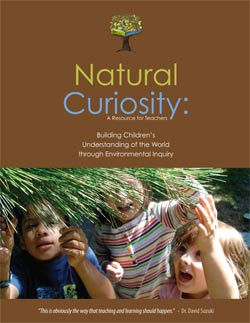Natural Curiosity is a resource for educators that was developed by the Laboratory School at the Dr. Eric Jackman Institute of Child Study, which is part of the Ontario Institute for Studies in Education (OISE) at the University of Toronto.
When the first edition of Natural Curiosity was launched in 2011, its goal was to introduce an inquiry-based approach to environmental education. This approach was situated within a longstanding tradition of progressive schooling that places children at the centre of their learning, responds to their lead as they construct meaning through engagement with the world, and supports the emergence of a community of learners.

Since its initial launch, Natural Curiosity has gained widespread implementation in schools, school boards, and ministries of education across the country and internationally. As environmental education becomes a priority for schools everywhere, the resource continues to be in high demand. In addition to high rates of electronic downloads of both French and English versions, more than 20,000 paper copies of the book have been printed and sold to date.
The first edition of Natural Curiosity began to reflect Indigenous approaches to learning in significant ways. The driving motivation for a second edition was the burning need, in the wake of strong and unequivocal recommendations by the Truth and Reconciliation Commission (2015), to bring Indigenous perspectives into the heart of Canadian educational settings and curricula, most notably in connection with environmental issues. Momentum gathered as points of convergence (as well as discontinuities) between Natural Curiosity’s approach and certain Indigenous perspectives were identified. Doug Anderson, who has thought long and deeply about such matters, agreed to articulate these perspectives in this edition; other experts offered their insights, and a project was launched with the support of TD Friends of the Environment, The Norman and Marian Robertson Foundation and private donors.
Natural Curiosity 2nd Edition: The Importance of Indigenous Perspectives in Children’s Environmental Inquiry supports a stronger awareness of Indigenous approaches to environmental learning. It offers an encounter with Indigenous perspectives that challenge us to think in very different ways about our place in the world. The Indigenous lens in this edition provides a starting point in a conversation that opens educators’ eyes to Indigenous perspectives as their students build lasting connections with the natural world.
New in the Second Edition:
Revision of the four branches of environmental inquiry by Julie Comay, Lab School teacher and researcher (building on original text by Lorraine Chiarotto, former Lab School teacher)
Indigenous lenses on each of the branches by Doug Anderson, Lab School parent and Indigenous educator
16 new educator stories including Lab School teachers: Cindy Halewood, Carol Stephenson, Zoe Donoahue, Mike Martins, Lisa Sherman, & Robin Shaw

On Thursday March 1, we are hosting the official launch of the Natural Curiosity 2nd Edition and would love current families and friends of JICS to join this celebration! Please register at nc2launch.eventbrite.ca!

The keynote speaker is Niigaanwewidam James Sinclair who is Anishinaabe (St. Peter’s/Little Peguis) and an Associate Professor at the University of Manitoba. He is an award-winning writer, editor and activist who was named one of Monocle Magazine‘s “Canada’s Top 20 Most Influential People” and one of the CBC Manitoba’s “Top Forty Under Forty.” He is a regular commentator on Indigenous issues on CTV, CBC, and APTN, and his written work can be found in the pages of newspapers like The Globe and Mail and online with CBC Books: Canada Writes. His first book on Anishinaabeg literary traditions will be coming out with the University of Minnesota Press in 2018.

